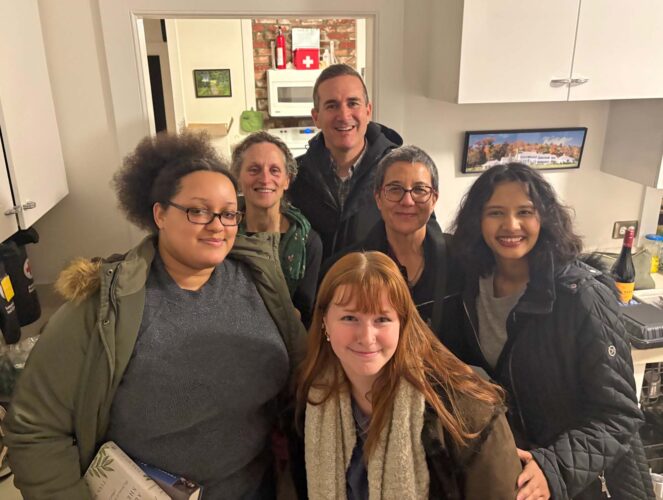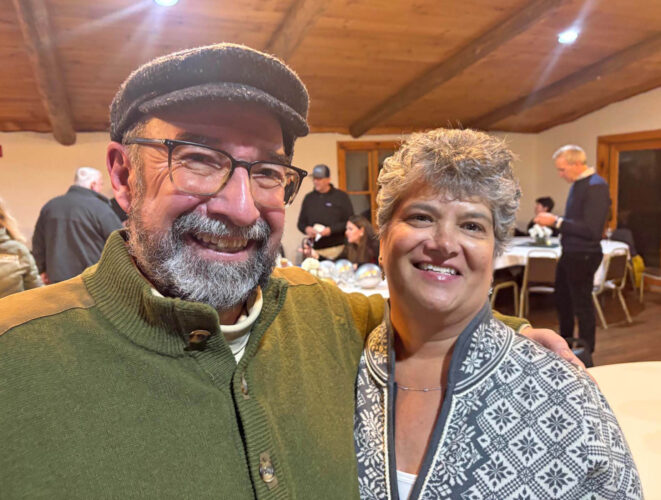Reenactments offer a window to birth of our nation
- Anna Olsen, originally from Brookfield-Washington, Vt., with Garth Olsen from Saranac Lake.
- Provided photos — Naj Wikoff Fort Ticonderoga President and Chief Executive Officer Beth Hill stands between Benedict Arnold — played by Cameron Green, Director of Interpretation at Fort Ticonderoga — and Ethan Allen, played by Thomas Tringale.
- Marge and Gary MacIntyre of Ludlow, Vt., with reenactor Richard Kenyon.

Anna Olsen, originally from Brookfield-Washington, Vt., with Garth Olsen from Saranac Lake.
Shouts of “No Quarter!” in the wee hours of May 10 scared the British soldiers and their wives 250 years ago as the Green Mountain Boys scaled the walls and burst into the courtyard of Fort Ticonderoga; shouts at that time meant all would be killed.
“It was pretty terrifying for the women and children,” said a reenactor, Emma Cross, playing a British soldier’s wife. “All the shouting and yelling, being dragged out of bed when you didn’t know what was happening. They were very confused, terrified. The Green Mountain Boys who showed up were not a regular army. In their eyes, they probably were a gang.”
Benedict Arnold, Ethan Allen, and the Green Mountain Boys’ capture of Fort Ticonderoga was the first rebel victory in the War for Independence. Had they attempted their raid just six hours later, they might not have succeeded as the British Guard under Lt. Arthur Wadman had been sent to reinforce the small British Garrison. Instead they, too, were captured upon arrival, becoming, with the Fort’s garrison, the first British prisoners in the four-year struggle.
The capture of the Fort was a huge morale boost to the struggling rebel forces, one that proved to be very significant as, in time, many of its mighty guns would be carried overland in the dead of winter to Boston, allowing General Washington to free that city from the British. Further, the Fort was to become a critical staging ground for Arnold to send the first ships of what would become the U.S. Navy up Lake Champlain to successfully hold off a British invasion, buying the rebel forces critical time, time that led to the British defeat in Saratoga.
The capture was significant as it included over 200 cannons, three mortars, sundry howitzers, 50 swivel guns, a capture that took a week for the Continental Congress to learn about, and one so significant, it forced them to consider the likelihood of an all-out war. Up to that point, the struggle was initially localized and defensive, such as repelling the British who invaded Concord and Lexington and holding back until the British “fired the first shot.” At Ticonderoga, the Americans went on the offensive, and did so collectively and successively. Rebels from three colonies attacked a British garrison located in a fourth. Further, once captured, Fort Ticonderoga needed to be reinforced and held. As a consequence, the whole nature and scope of the coming conflict changed.

Provided photos — Naj Wikoff Fort Ticonderoga President and Chief Executive Officer Beth Hill stands between Benedict Arnold — played by Cameron Green, Director of Interpretation at Fort Ticonderoga — and Ethan Allen, played by Thomas Tringale.
A further example is that maintaining the Fort required reinforcements from Connecticut and Massachusetts, as New York’s resistance was not as advanced as that of the New England colonies. On May 11, Capt. Edward Mott, of Col. Samuel Parson’s Connecticut Regiment, which sent men to help capture the fort, wrote that “it was not Connecticut or Massachusetts men who captured Fort Ticonderoga, but American forces,” one of the first official descriptions of a collective identity for the people of the 13 original colonies.
Over the weekend of May 9 to 11, Fort Ticonderoga held a reenactment of this critical early action in the American Revolution, one of many that the Fort will host over the coming years as part of the 250th Commemoration of the War of Independence. This time around, unlike 250 years ago, the reenactors had to deal with heavy rains on Friday and off-and-on showers Saturday, but deal with them they did. Several shared that, as they had no change of clothes, as was true during the march across Vermont and the raid, they had put wet clothes on in the mornings and slogged on, looking authentically bedraggled when they reenacted the raid and capture of the Fort.
Attendees also learned that the famous quote attributed to Ethan Allen, when asked by what authority he demanded their surrender, attributed to him, “In the name of the Great Jehovah and the Continental Congress,” was written by him five years later. However, journals and letters written by others, including Lt. Jocelyn Feltham, provided a more nuanced description of the surrender. Visitors to the reenactment also learned that the person answering the door was not Captain William Delaplace, who was putting on his uniform, but Lt. Feltham. Much to Ethan Allen’s chagrin, they would not surrender to him, as he held no official military title, but only to Col. Benedict Arnold, a rank given to him by the Massachusetts Committee of Safety.
“I hope this, and our upcoming reenactments, will be a window into the beginning of people’s path of connecting with the history, and understanding the sacrifices, the triumphs, the struggles, challenges, tragedies, and complexities of our nation’s founding and what that means to us today,” said Beth Hill, President & CEO of Fort Ticonderoga. “The Continental Congress wasn’t even aware that Allen, Arnold, and the Green Mountain Boys took the fort until a week later, and then, there was a conversation, ‘Can we give it back?” There was a great and growing understanding of the value of all the cannons and other munitions captured, questions as to who owned the land, whether it was New York or New Hampshire, and concerns about Vermonters and others being fired upon. I urge people to dive into our YouTube pieces done by curator Dr. Matthew Keagle on all of these threads that were going on.”
“It’s cool, really great to be here,” said Anna Olsen, from Brookfield/Washington, Vt. “I’ve never been to a historical site on such a remarkable occasion as this one with such a big reenactment happening.”

Marge and Gary MacIntyre of Ludlow, Vt., with reenactor Richard Kenyon.
“It was great to witness so many people who are so passionate about making sure history doesn’t die by showing as accurately as possible what took place and what it used to be like in the 18th century,” said Gath Olsen, who hails from Saranac Lake.
Pulling off this reenactment took many years of research, planning, and commitment. They knew that no matter what Mother Nature sprang on them, they’d do their best to provide a real-time, accurate portrayal of events along with insightful commentary and exhibits.
“We worked with volunteers from around the country,” said Dr. Matthew Keagle, Curator. “The core of our team is driven by our staff who work year-round to develop this event, build the standards, and bring in volunteer reenactors. Many of the reenactors are other museum professionals who have come up to participate in the staging of the capture of the fort and the many other special events we’ll showcase this year and over the next several years. It shows the reach and value of what Fort Ticonderoga does and the dedication of the many people who
come to help us so we can get the numbers as close as possible to the original scale of when the events happened.”
There many ongoing and special reenactments, exhibitions and tours at the Fort, check their website for details https://fortticonderoga.org



